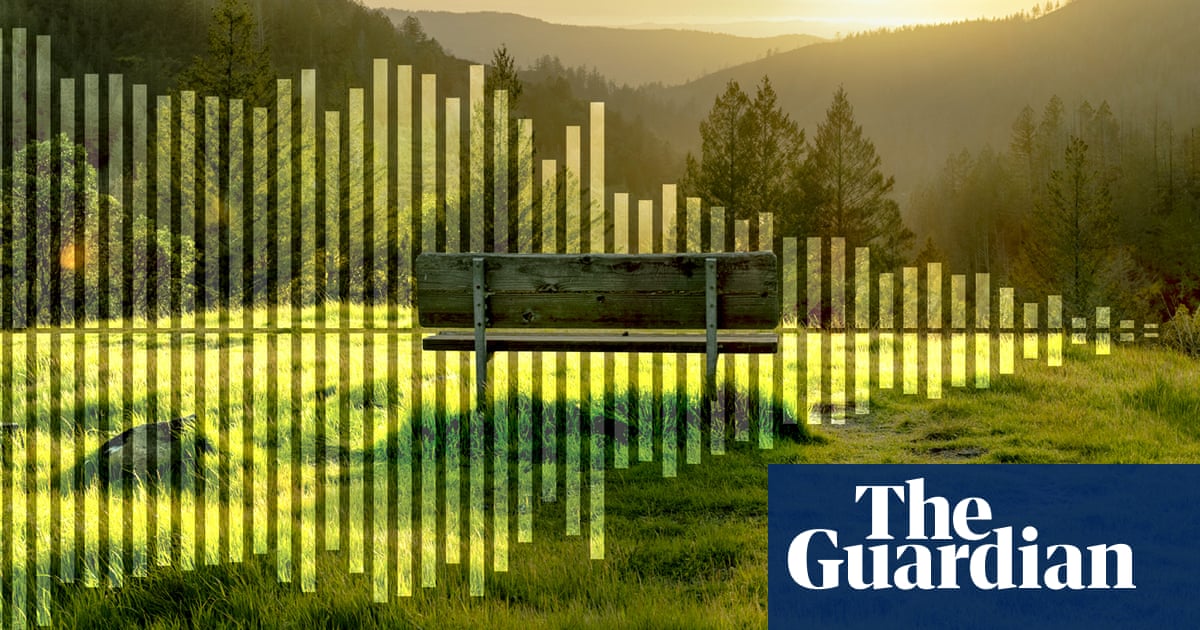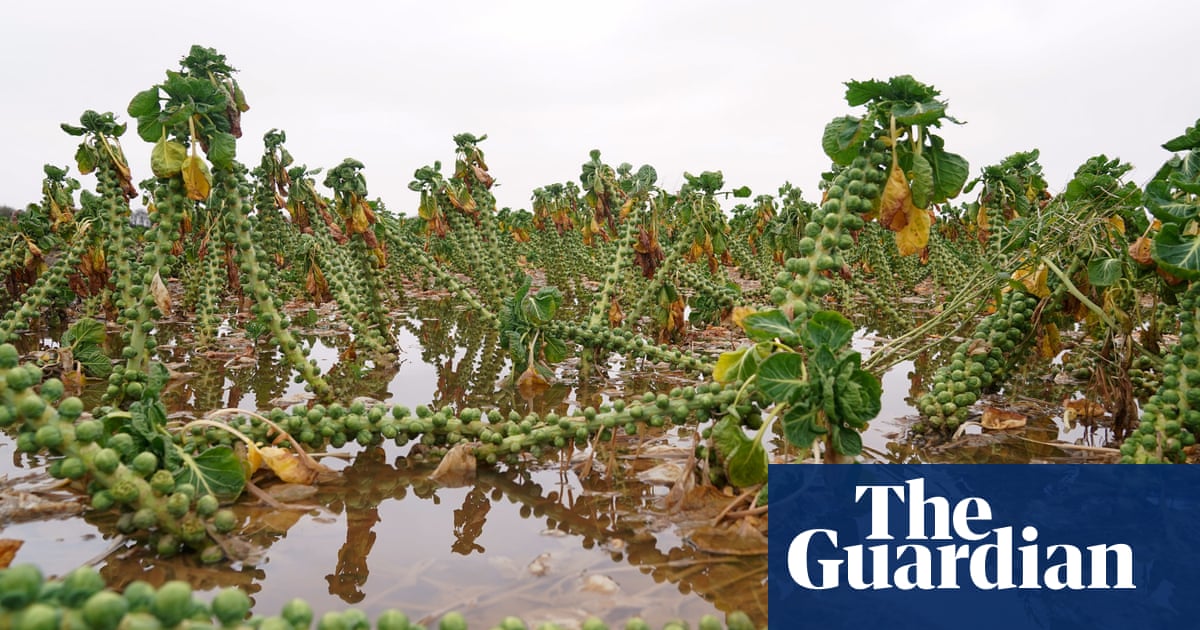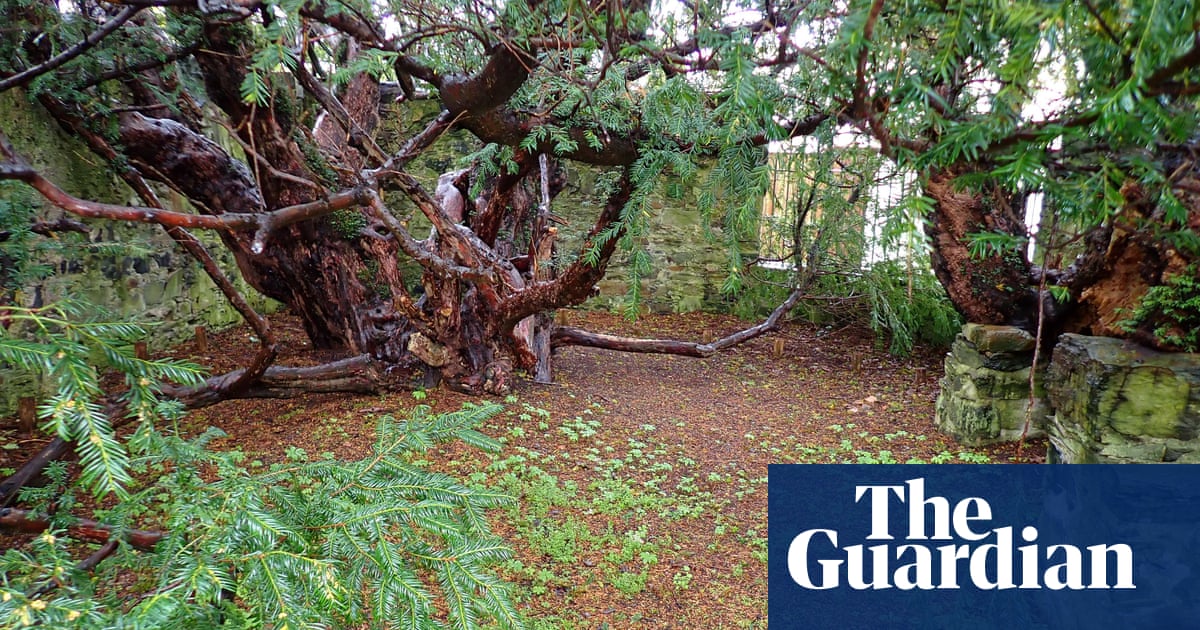The tale starts 30 years ago, when Bernie Krause made his first audio clip in Sugarloaf Ridge state park, 20 minutes’ drive from his house near San Francisco. He chose a spot near an old bigleaf maple. Many people loved this place: there was a creek and a scattering of picnic benches nearby.
As a soundscape recordist, Krause had travelled around the world listening to the planet. But in 1993 he turned his attention to what was happening on his doorstep. In his first recording, a stream of chortles, peeps and squeaks erupt from the animals that lived in the rich, scrubby habitat. His sensitive microphones captured the sounds of the creek, creatures rustling through undergrowth, and the songs of the spotted towhee, orange-crowned warbler, house wren and mourning dove.
Back then, Krause never thought of this as a form of data-gathering. He began recording ecosystem sounds simply because he found them beautiful and relaxing. Krause has ADHD and found no medication would work: “The only thing that relieved the anxiety was being out there and just listening to the soundscapes,” he says.
Inadvertently, he had begun to gather a rich trove of data. Over the next three decades he would return each April to the spot at the bigleaf maple, set his recorder down and wait to hear what it would reveal.
But in April last year, Krause played back his recording and was greeted with something he had not heard before: total silence. The recorder had run for its usual hour, but picked up no birdsong, no rush of water over stones, no beating wings. “I’ve got an hour of material with nothing, at the high point of spring,” says Krause. “What’s happening here is just a small indication of what’s happening almost everywhere on an even larger scale.”
A rich weave of sound fades
Animals produce a vast array of sounds: to find mates, protect territories, identify offspring or simply by moving about. But traditionally, ecologists have measured environmental health by looking at habitats rather than listening to them. Krause developed the idea that the sound of healthy ecosystems contained not only the calls of individual animals, but a dense, structured weave of sounds that he called the “biophony”.
In 2009, when Krause listened through his archive, he realised a story was emerging: a subtle but noticeable loss in the density and variety of natural sounds.
At the same time, he began observing odd things happening in Sugarloaf Ridge park. Leaves on some tree species were unfurling two weeks earlier than documented in historical records. The change in bloom meant migrating birds following the Pacific Flyway were out of sync with sources of food along their route. Winter rain patterns had changed. Then in 2012, exceptional drought conditions started. California had been getting little rain and record hot temperatures, which pushed the parched land into unprecedented territory.
By 2014, northern California was experiencing its most serious drought in 1,200 years, and the bird song in Krause’s recording becomes muted.
In 2015, the quiet sets in. There is no stream flow or wind in the audio. In 2016, the hush is broken only by the call of a purple finch.
“A great silence is spreading over the natural world even as the sound of man is becoming deafening,” Krause wrote in 2012, in his book The Great Animal Orchestra. “The sense of desolation extends beyond mere silence.”
Life swept away by fire
Then, in 2017, the Tubbs fire struck, the most destructive wildfire in northern California’s modern history.
Krause happened to be awake at 2.30am on the October morning when the flames reached his home. He and his wife had to run through a wall of fire surrounding the house. “Except for us, not one single item that we had amassed over the arc of our lives survived,” he says. “As we raced toward the car, a fire tornado seethed with a voice of rage.
“That sound haunts us to this day,” he says. “I rarely make it through a night without awakening to frightful sonic nightmares.”
Propelled by gusts of 78mph, the fire incinerated entire neighbourhoods. Krause’s cats, Seaweed and Barnacle, died. He lost 70 years of letters, photographs and field journals, in flames so intense they left the refrigerator an unrecognisable puddle of aluminium and steel. His precious recording archive survived, in copies stored elsewhere.
The Tubbs fire burned 80% of Sugarloaf Ridge park. John Roney, the park manager, managed to evacuate 50-60 campers as the fire roared towards them.
The bigleaf maple survived. It stood up to the fire,” says Breck Parkman, a retired state parks archaeologist. “It lost branches and got partially stunted, but it survived.” But in September 2020, the Glass fire hit: one of nearly 30 wildfires across California that month.
“That pretty much finished off what was left of that tree,” says Parkman. He remembers once taking Clint Eastwood to look at it, as well as some botanists trying to establish if it was the biggest maple in the American west – they never confirmed its status. “It didn’t really matter, though. The birds knew the tree was grand. For them, this was the tree of life,” he says.
He believes the tree should have lived for a few hundred more years and likens it to an elder at family gatherings who brings wonderful food. One day that person disappears. “It’s a type of sadness – it’s hard to describe,” he says.
“It’s a loss, and there’s a longing. I would suspect the birds still miss that tree. I do.”
Many forest ecosystems are reliant on fire to decompose dead wood and old leaves but historically these tended to be smaller fires. They did not typically burn the tree canopy, so insects and other animals could take refuge without getting scorched. The larger fires in recent years are much hotter and threaten endangered species that have restricted ranges.
Desirae Harp, an educator at the state park and member of the local Mishewal Wappo tribe, says the silence that fell after the fires broke her heart.
“Hearing that silence, of all those native plants and animals, is heartbreaking because those are our relatives. I feel like when human beings die we call it genocide. But when we destroy whole ecosystems, we don’t always understand the weight of that.”
A silent message to the world
One of the most significant environmental books of the 20th century is Silent Spring by Rachel Carson. Published in 1962, it warned that if people did not stop their destruction of nature, especially through the use of pesticides such as DDT, the number of birds and other wild creatures would continue to decline and silence would begin to fall over the natural world.
In Krause’s recording from April 2023, not only is the birdsong missing, but there is no water in the creek either. “We’re watching this in our own lifetime, which is startling,” he says.
Comparison of 2003 and 2023:
In 2019, Krause argued that the climate crisis could be “changing the Earth’s natural acoustic fabric”. He drew an analogy between the natural world and a concert hall: if the heat and moisture of the concert hall changed, so too would the players’ ability to perform.
“The same is happening for Earth’s orchestra. New atmospheric conditions are detuning natural sounds,” he wrote. “Only major mitigation actions will help preserve Earth’s beat.”
One of the reasons people were first drawn to Sonoma county, where most of the state park lies, was to go fishing, hunting and swim in the creeks. In the 1970s there were many places to swim, says Steven Lee, a research manager at Sonoma Ecology Center. “People don’t swim in the creeks here any more. Why not? Because there’s not enough water.”
The biodiversity associated with the streams has also been lost. Chinook salmon and steelhead trout are unable to reach their spawning grounds if there is no water. “It’s definitely drastic,” says Lee, about Krause’s latest recording. “The pessimist in me would say that we’re probably going to see a lot of these declines continue to happen.”
Waterways are critical lifelines for wildlife in dry places such as California, with a whole cascade of life depending on them. Droughts mean this lifeblood no longer flows through the landscape.
Caitlin Cornwall, a project manager at the Sonoma Ecology Center, says: “There is a direct link between reversing climate change and having more birds in Bernie’s recordings.
She calls Sugarloaf “a relatively mid-range example of what happens when you have an extreme drought”.
The drought is not the only pressure. Across the state, human activity is cutting into animal food sources and habitats. Wild places are being converted into farmland and urban areas, and invasive species are becoming more common. Some of the songbirds Krause captured in 1993, such as the orange-crowned warbler, are now in widespread decline.
Many of the birds captured in Krause’s recordings are migrant species “living on a knife-edge”, says Cornwall. “If a year’s cohorts have died in a particular place, then next year the young – and even the adults – might not come back.” It could take generations for them to recolonise a habitat – assuming they survive elsewhere.
Krause, who has been recording ecosystems from Africa to Latin America to Europe, says it is depressing to hear how the places he visits have changed. His personal library contains more than 5,000 hours of recordings, taken over 55 years from all over the world. He estimates that 70% of his archive is from habitats that have now disappeared.
“The changes are profound,” he says. “And they are happening everywhere.”
“I’ve got to this point in my life now where I just don’t know quite how to handle it, or how to express it, or what to say – yet I’ve got to tell people what I see and what I hear. Actually, I don’t need to say anything – the messages are revealed through the soundscapes.”
There have been some optimistic signs at Sugarloaf Ridge. Roney has 40 cameras around the park, which have taken 60,000 photos in the past five years. He says there are hopeful indications, such as black bears and mountain lions moving into the area. Krause is 85 now and says his hearing days are numbered: he is almost totally deaf in his right ear and has some hearing loss in his left. He can no longer hear subtle changes in sound like he used to. “That’s a loss that I quite regret but have learned to live with,” he says.
Still, he looks forward to spring and to his next recording in Sugarloaf Ridge. He is hopeful that this year there could be signs of a resurgence. “The stories conveyed through the voices of these critters will tell us all we need to know that’s worthwhile,” he says. “When we finally learn how to listen.”
Find more age of extinction coverage here, and follow biodiversity reporters Phoebe Weston and Patrick Greenfield on X for all the latest news and features


